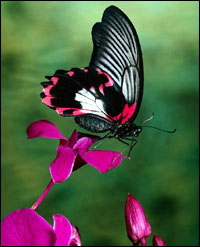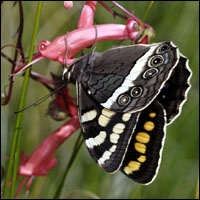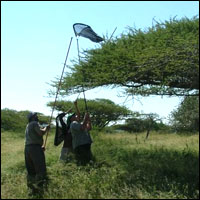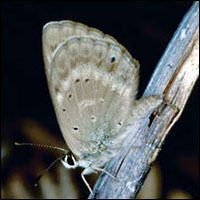Butterfly conservation gets wings with new atlas project
|
A conservation project aimed at determining the distribution of all
butterfly species in South Africa, Lesotho and Swaziland and thereby
providing information for the conservation of this group of insects,
especially those threatened with extinction, was launched in May
2007.
Three institutions joined forces to implement the Southern African Butterfly Conservation Assessment (SABCA) - the South African National Biodiversity Institute (SANBI), the Lepidopterists’ Society of Africa (LepSoc) and the University of Cape Town’s Avian Demography Unit (ADU).
What is a conservation assessment?
A conservation assessment describes the likelihood of a species becoming extinct, and is the basis for Red Data lists. Species listed as Critically Endangered, Endangered or Vulnerable (collectively referred to as "Threatened” species) are those that are assessed as having a high risk of extinction in the near future. Conservation assessments highlight species and areas of significant conservation importance, providing baseline information that is needed for conservation planning.The first butterfly Red Data book was published in 1989. This book is currently being updated by a group of biologists who helped to found SABCA. However, large gaps still exist in our knowledge of butterflies, and these must be filled by SABCA so that the appropriate conservation management actions can be taken for the threatened species.
Nature conservation authorities, universities, museums, amateur lepidopterists and members of the public have been part of the planning and strategizing that have brought SABCA into being. The project is co-funded by the Norwegian Ministry for the Environment and SANBI through its Environment Cooperation Programme.
“The SABCA Atlas will help us to fill in the many gaps in our knowledge of butterflies and their threats. With this information we can make sure that we implement the correct conservation actions to prevent more extinctions,” said SANBI Threatened Species Programme Manager, Wendy Foden, at the launch.
South Africa is richly endowed with unique butterfly species, many of them endemic. But, said Hermann Staude, president of the Lepidopterists’ Society of Africa, two - possibly three - of our 671 known butterfly species have become extinct. A further 38 species appear in the Red Data List, meaning they are threatened with extinction in the near future.
The project coordinator for SABCA, Silvia Mecenero, pointed out that unless South Africa paid careful attention to the conservation of its butterflies, we could lose many more of these fascinating creatures, as well as lose out on the important services which they provide to our ecosystems.
Butterflies are one of the most diverse groups of insects, and play an important ecological role by pollinating flowering plants. In South Africa, the Mountain Pride (Aeropetes tulbaghia) butterfly is known to be the only pollinator of several red flowering plants, such as the red “Pride of Table Mountain” orchid (Disa uniflora).
Butterflies in the Lycaenid family in South Africa are mostly endemic and do not occur anywhere else in the world. South Africa has one of the highest proportions of Lycaenid butterflies (48%) for any region in the world. Of the 38 threatened butterfly species included in the proposed Red Data Book, about 90% are Lycaenids. These butterflies have life cycles that are closely linked with specific plant and ant species and many only occur in very small, confined areas.
Because butterflies tend to rely on particular host plant species for food, they are particularly vulnerable to the transformation of natural lands. The destruction of natural vegetation for agriculture, urbanization and infrastructure is the main cause of butterfly declines and extinctions. Butterflies are also known to be particularly sensitive to climate change as a result of global warming.
SABCA will be coordinated by the ADU, which is experienced in running atlas projects, having successfully coordinated the bird and frog atlas projects. The ADU is also coordinating the Southern African Reptile Conservation Assessment (SARCA).
LepSoc is an amateur society that was formed 24 years ago to encourage the study and conservation of butterflies and moths in Africa. LepSoc will be responsible for the collection of butterflies in the field, as well as providing expertise in identification of butterflies. LepSoc has already been involved in the proclamation of at least four conservation areas for specific butterfly species, including for the critically endangered Brenton Blue (Orachrysops niobe) butterfly.
SANBI, a statutory body under the Department of Environmental Affairs and Tourism and the host of the newly established SAEON Fynbos Node, is responsible for fulfilling the new Biodiversity Act mandate to monitor and report on the state of South Africa’s threatened biodiversity. SABCA is the first major project on insects to be undertaken by this Institute.
SABCA aims to train and educate previously disadvantaged groups to promote butterfly conservation. The public will also have opportunities to participate in this important project.
How can members of the public get involved in SABCA?
Previous atlas projects for birds, frogs and reptiles, show that the public can play an extremely useful role in species conservation. Anyone can become involved in SABCA in any of three ways:
- SABCA urges members of the public to take digital photographs of the butterflies (at any of their life stages i.e. caterpillars, pupae or as adult butterflies) they see in gardens, on holiday and those killed on the roads. Together with the details of where they were taken, these photographs can be submitted to the project’s website “Virtual Museum”. Records that are of good quality will be entered into a butterfly database and will be available for use as an educational resource to all.
- Volunteers can join the SABCA team on field trips into previously poorly studied areas to collect butterflies and information about the butterfly habits and habitats.
- People with private butterfly collections are encouraged allow the project’s data capturers to identify and record the species in the collections and the areas and dates of collection.
For more information on SABCA and on how to participate, visit the project website: http://sabca.adu.org.za, or contact Silvia Mecenero (Project Coordinator) on Email: sabca@adu.org.za; Telephone: (021) 650 3426; Cell: 084 702 4485.














